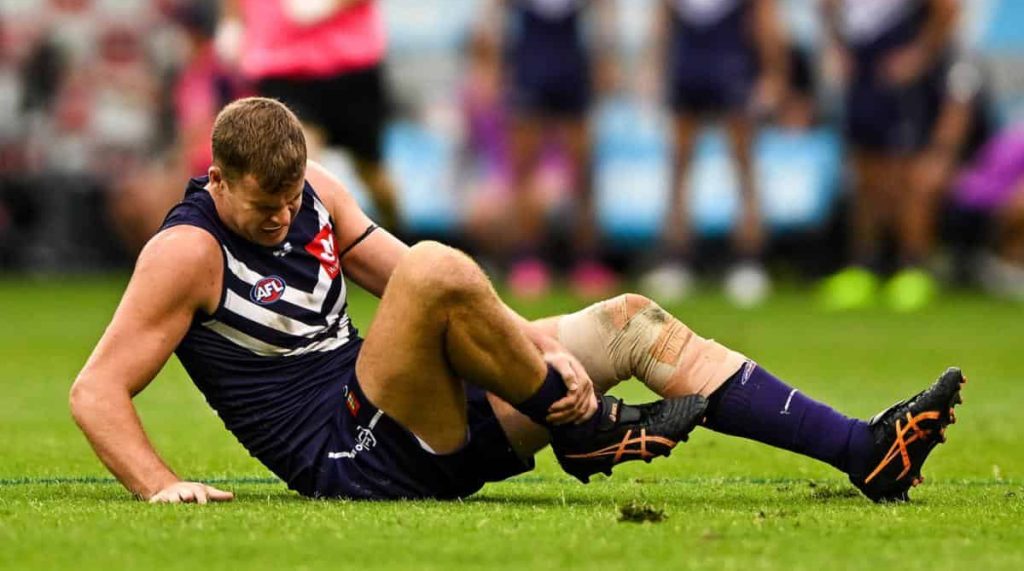If you watch a lot of AFL, you have probably heard the word “syndesmosis” from commentators and coaches a lot more often in the past few years, when talking about a player’s ankle injury. In 2021, syndesmosis injuries were the most common ankle injury affecting AFL players. Here at Core Physio, our Physiotherapists are able to treat syndesmosis and other ankle injuries.

Original image source: Browner B, Jupiter J, Levine A, Trafton P: Skeletal Trauma: Fractures, Dislocations, Ligamentous Injuries, ed 3. Philadelphia, PA, Saunders, 2003, vol 2, p 2307-2374.
What is Ankle Syndesmosis?
A syndesmosis injury is different to a standard ankle sprain. Often, ankle sprains affect the lateral ankle ligaments such as the anterior talofibular ligament (ATFL) or calcaneofibular ligament (CFL), and occur during sudden and excessive inversion (and sometimes dorsiflexion) of the ankle. A syndesmosis injury most often occurs when the foot is planted on the ground, and the leg is internally rotated, causing the foot to externally rotate relative to the tibia and fibula above it. This movement causes the tibia and fibula to be forced against the wider portion of the talus bone below, and can result in the bones being forced apart. This can injure the interosseous membrane and/or the ligaments binding these two bones (anterior and posterior inferior tibiofibular ligaments), resulting in a syndesmosis injury.
AFL Ankle Ligament Injury Incidence By Year- Per Club, Per Season*

Source: 2021 AFL Injury Report
*Note: All incidence data contained in the 2021 AFL Injury Report reflects the average number of injuries per club scaled to a list size of 40 players over a season of 22 matches.

Symptoms & Treatment
Signs and symptoms of a syndesmosis injury can include:
• Pain above the medial and lateral malleoli (bumps) of the ankle
• Pain that increases when standing, walking or rotating/moving the foot
• Tenderness to touch
• Bruising and swelling may occur down the front and outside of the ankle
To diagnose a syndesmosis injury, a physiotherapist will ask about the mechanism of how the injury occurred, and will perform several physical tests to rule out other structures or causes of the ankle pain. Sometimes, an x-ray might be required to rule out any fractures, and a CT scan can show the increase in distance between the tibia and fibula which occurs as a result of the injury.
For major syndesmosis injuries, where the ankle becomes unstable, surgery is required. Around 8 years ago, the expected recovery time for major syndesmotic injuries was 8 months, however due to advancements in diagnosis and surgical methods, this has now become a 6-10 week recovery and rehabilitation period post-surgery. For minor syndesmosis sprains, this can also take around 6-10 weeks to return to sport, however surgery is not required. The post-surgery and non-surgical rehabilitation programs for a syndesmosis injury are similar, and begin with a period of altered weight-bearing in a moon boot and ankle range of motion exercises, followed by leg strengthening exercises and single-leg proprioceptive exercises.
In the article below, Geelong player Cameron Guthrie discusses his syndesmosis injury in 2018, his surgery, and what his recovery and rehabilitation period entailed: https://www.aflplayers.com.au/news-feed/stories/what-is-syndesmosis
This blog was written by Josh Gauci (Physiotherapist), from our Burnside practice.
References
AFL Doctors Association, AFL Physiotherapists Association and AFL (2022) 1st edn, 2021 AFL Injury Report. 1st edn. rep. Melbourne, VIC: AFL, pp. 1–13.
Guthrie, B., Buchanan, C. and Contributor (2021) What is syndesmosis?, AFL Players’ Association Limited. Available at: https://www.aflplayers.com.au/news-feed/stories/what-is-syndesmosis (Accessed: March 4, 2023).
Samara, D. (no date) Dr David Samra: Sports Medicine Sydney: Ankle and syndesmosis injuries, Dr David Samra, Sport and Exercise Medicine. Available at: https://www.drdavidsamra.com.au/ankle-and-syndesmosis-injuries (Accessed: March 4, 2023).
Syndesmosis (2019) Peak Physio. Available at: https://www.peak-physio.com.au/education/ankle-syndesmosis-injury-high-ankle-sprain/ (Accessed: March 4, 2023).
